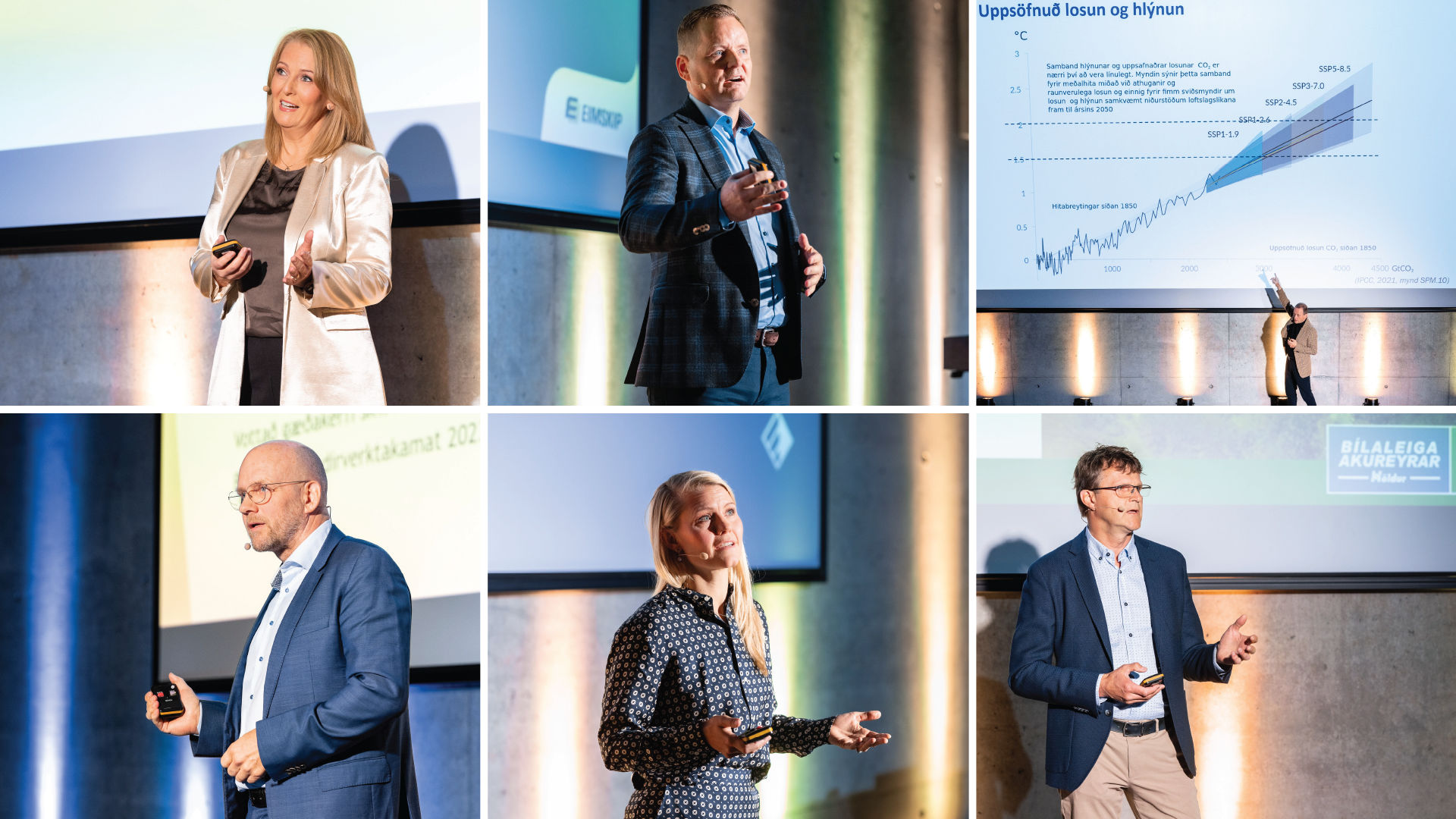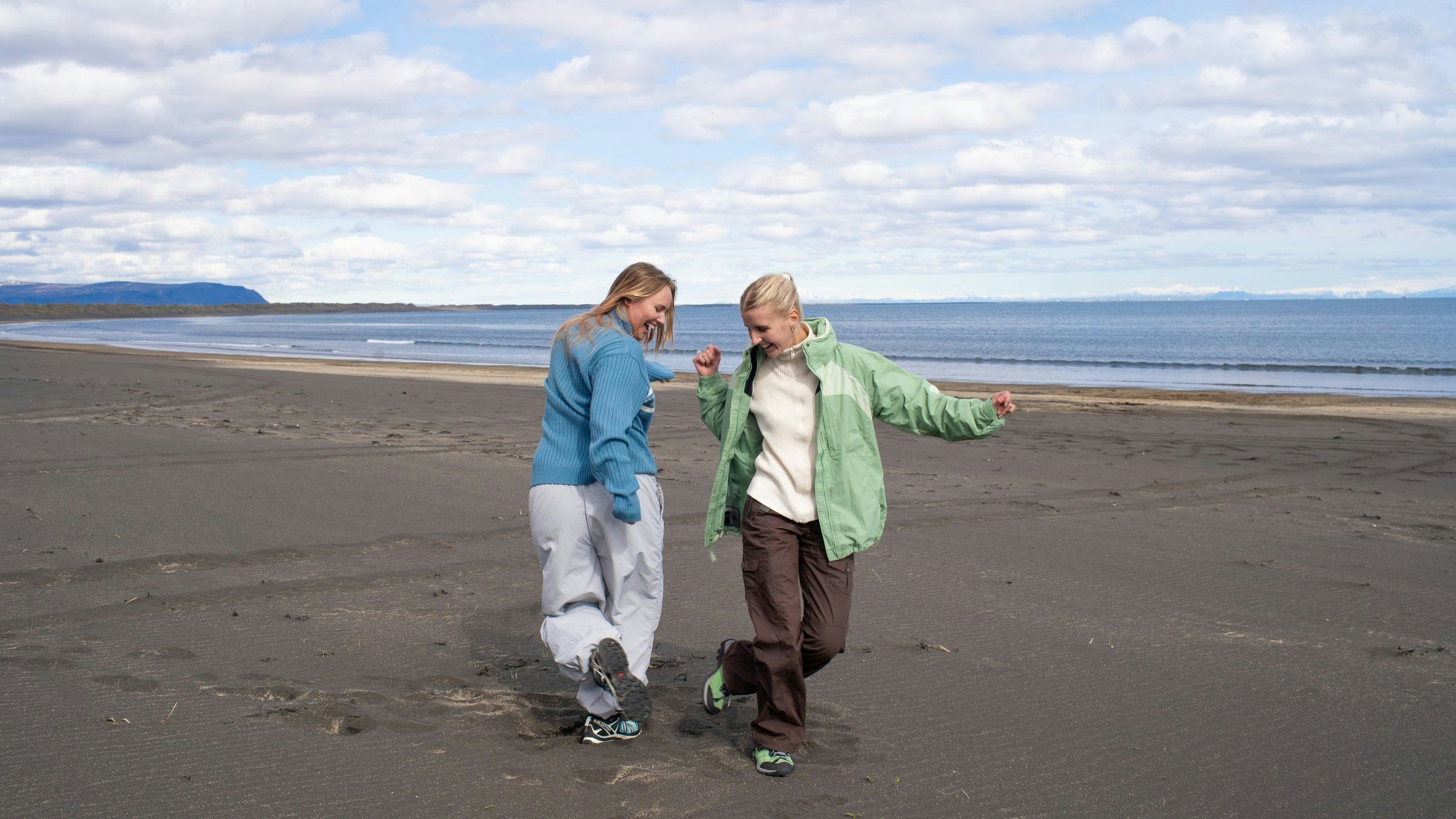Cookies
By clicking "Allow All", you agree to the use of cookies to enhance website functionality, analyse website usage and assist with marketing.
More on cookiesRapid developments in sustainability
In 2024, we hosted Landsbankinn’s Sustainability Forum for the third time, assessed greenhouse gas emissions from our credit portfolio for the fourth time and adopted science-based emission targets which were verified in February 2024. Five interesting projects received grants from Landsbankinn’s Sustainability Fund in the third round of allocations and we maintain a leading ESG risk rating in Sustainalytics’ assessment of risk from environmental, social and governance factors.

Landsbankinn's Sustainability Policy
Our Sustainability Policy extends to all divisions of the Bank, sets out our key focus as regards sustainability and describes how we will implement sustainability in our operation. The Policy addresses the UN SDGs, climate concerns, social issues, governance, ESG risk rating, responsible investment and responsible lending.
Goals are instrumental to achieving success, in sustainability much as in other fields. We have challenged ourselves with ambitious goals which we review regularly and are based on the Bank’s Sustainability Policy. Landsbankinn’s disclosure is also linked to its sustainability goals and we publish information about our progress, both in order to promote transparency and to share information. Our eight goals fall into the categories sustainability, environment, social and governance. The goals are published to the Bank’s website alongside its annual financial statement.
Landsbankinn’s Sustainability Forum
Landsbankinn hosted its third Sustainability Forum on 4 September. The event was well attended. At the Forum, leaders of five Icelandic companies presented their successes and challenges in sustainability and one of our foremost climate specialists described the consequences of climate change and necessary mitigating action.
Lilja Björk Einarsdóttir, CEO of Landsbankinn, opened the meeting and spoke about the cyclical nature of green funding. She was clear on the overarching goal: To contribute to a better future and limit global warming to within 1.5°C above average pre-industrial levels, in accordance with the Paris Agreement.

Impact on biodiversity
Biodiversity describes changes to ecosystems, species and genes in the world or in a certain area. Biodiversity and climate change are closely linked and achieving climate goals requires halting the decline in biodiversity. One key difference between the two issues is that greenhouse gas emissions impact the entire planet, regardless of where they originate, whereas biodiversity loss is often localised. For this reason, businesses must carefully assess both their impact on biodiversity and the risks they face due to biodiversity decline, based on the geographic locations of their value chains. Since Landsbankinn operates exclusively in Iceland, we focus on Icelandic conditions in this context.
Landsbankinn has been a member of the Partnership for Biodiversity Accounting Financials (PBAF) since 2022, an association working to enable financial institutions to assess and disclose impact and dependencies on biodiversity of loans and investments. In January 2024, Landsbankinn committed to disclosing how its operations impact nature and biodiversity, in line with the guidelines of the Taskforce on Nature-related Financial Disclosures (TNFD). Landsbankinn will publish nature-related financial information as of 2026.
At the outset, our aim is to ascertain whether the changes that are occurring will have a material impact on the Bank’s loan portfolio to the fisheries and seafood sector, and the potential to have a positive impact through our customers. The aim is also to assess whether rising temperatures and acidification can cause specific commercial fishing stocks to migrate and whether new stocks may replace them. This will improve our understanding of the potential changes in seafood and fisheries, and the possible effect on our lending to the sector. As before, we rely on data from the Marine and Freshwater Research Institute (HAFRÓ) and the Fourth Report of the Scientific Committee on Climate Change in Iceland.
Responsible investment and responsible lending
We have emphasised responsible investment for a number of years now, as the strategy positively impacts return on investment in the long term and reduces operational risk. We are guided by the UN Principles for Responsible Investment (UN PRI). We wish to be a leader in responsible lending as well, as the methodology reduces operational risk for companies.
Landsbankinn measures its green asset ratio (GAR) based on the EU Taxonomy and Bank has set sustainable lending goals that align with its Sustainable Finance Framework, cf. the Bank’s sustainability goals.

Science-based climate targets
Landsbankinn’s goals to reduce greenhouse gas emissions were verified by the Science Based Targets initiative (SBTi) in February 2024. The Bank’s target supports the goals of the Paris Agreement.
Landsbankinn has undertaken to reduce emission under Scopes 1 and 2 by 95% before 2030 compared with 2019, the Bank’s reference year for the purpose of these goals. Landsbankinn has also obliged itself to continue to purchase renewable energy until 2030.
The Bank’s main impact is through financed indirect emissions under Scope 3. Our financed emissions fall under five categories and the SBTi addresses this division in its review of the goals and the verification process.
The process behind verification of science-based targets for emission reduction requires a great deal of work. Our journey began with the signature of the Climate Goals of Festa and the City of Reykjavík in 2015 but at the time, no methodology was in place to measure financed emissions.
Landsbankinn has participated in the development of standards and methods, working with other financial undertakings on an international setting. The PCAF methodology is the result of that work and it is used by most financial undertakings who measure financed emission.
When the outcome of our measurements was ready, work began to set targets based on the outcome using the SBTi guidelines for financial undertakings.
Landsbankinn undertook to adopt SBTi targets and apply for verification in April 2022. The Bank’s targets were verified 12 February 2024 and published to the SBTi website on 22 February 2024.
Updated Sustainable Finance Framework
In early 2024, Landsbankinn published its updated Sustainable Finance Framework with a second-party opinion from Sustainalytics. Landsbankinn finalised the sale of green bonds in the amount of EUR 600 million in two issuances under the Framework, bringing total green issuances in EUR to five.
Sustainable finance frameworks clearly define how funds raised through bond issuances or deposits will be allocated in a transparent and accountable manner.
Landsbankinn’s Sustainable Finance Framework sets out criteria for its funding of environmental and social initiatives.
The Framework is based on ICMA’s guidelines and the EU’s Taxonomy for green and social financing and the criteria for sustainable projects.
Landsbankinn’s Sustainable Finance Framework reflects the principles the market has agreed upon as an effective definition of projects that promote sustainability and the structure industries should adhere to in this regard. In most cases, the focus is on steering the economy towards the goals of the Paris Agreement. To achieve this target, attention is paid to corporate energy use, transitioning from fossil fuels to renewable energy sources, building infrastructure for renewable energy, and more.
Transparency in allocation
Landsbankinn publishes an annual allocation report which details the projects financed by green bond issuances. The Bank’s Risk & Finance Committee operates a subgroup responsible for determining which funds qualify under the Framework and how they should be allocated across categories. Each year, the subgroup submits a proposal for the allocation of funds tied to outstanding green bonds to the Risk & Finance Committee. Once the allocation proposal is approved, a report is published on the Bank’s external website to inform investors. The allocation report is issued with third-party verification.
Landsbankinn will publish an allocation and impact report on outstanding issuances and financed projects toward the end of February.
Eligible projects in the Bank’s loan portfolio
Landsbankinn’s Sustainable Finance Framework outlines the specific requirements each project category must meet to qualify under the Framework. There are seven categories for green or blue projects and three categories for social projects.
Lending to eligible projects under the Framework amounts to a total of ISK 251,220 million.
Eignadreifing and Vaxtareikningur sjálfbær
We continue to offer sustainable investment methods, on the one hand with Eignadreifing sjálfbær, sustainable asset allocation fund, managed by Landsbréf and on the other with Vaxtareikningur sjálfbær, sustainable savings account. Eignadreifing sjálfbær was launched in 2021 as a specialised fund for retail investors. The fund integrates ESG factors into its investment decisions and is classified as an Article 8 fund under the SFDR regulation, meaning it actively promotes sustainability through its investments. At all times, at least 80% of the fund’s assets are allocated to sustainable investments. Vaxtareikningur sjálfbær, also introduced in 2021, allocates deposits to the financing of projects that contribute to sustainable development. Our customers can use these investment channels to let their savings positively impact the environment and community while achieving good returns.
Green vehicle loans
Landsbankinn supports the energy transition. Electric cars are an important aspect of the transition as their emission factor is lower and their operation more efficient, especially in Iceland. We offer a 50% discount on the borrowing charge on electric cars and a 0.6 percentage point discount on their financing.
The share of car loans for electric vehicle purchases grew steadily from 2020, reaching a peak in 2023 when they accounted for 46% of the total car loan volume issued to Landsbankinn customers. In line with the decline in new electric vehicle sales in 2024, this share fell to 29.3%. By the end of 2024, approximately one-third of all car loans to individuals in the Bank’s total loan portfolio were used to finance electric vehicles.
ESG ratings by independent parties
In recent years, investors have looked to third-party assessment of how companies manage ESG factors. These evaluations examine whether companies face financial risks related to their management of ESG issues.
Since 2019, Landsbankinn has obtained a solicited ESG risk rating from Sustainalytics. At the end of 2024, the Bank underwent a comprehensive reassessment by Sustainalytics. The result of the reassessment was that the Bank’s rating rose to 15.4 points on a scale to 100, where 0 indicates no risk, and the rating was revised from negligible to low risk. As work on sustainability at the Bank has only progressed between assessments, clarification was requested to which Sustainalytics responded that changed methodology had resulted in a higher rating. At the same time, Sustainalytics announced plans to discontinue ESG assessments for companies that are not publicly listed.
Landsbankinn also receives an ESG rating from the domestic rating agency Reitun and maintained an excellent score in 2024, achieving 90 out of 100 in category A3.